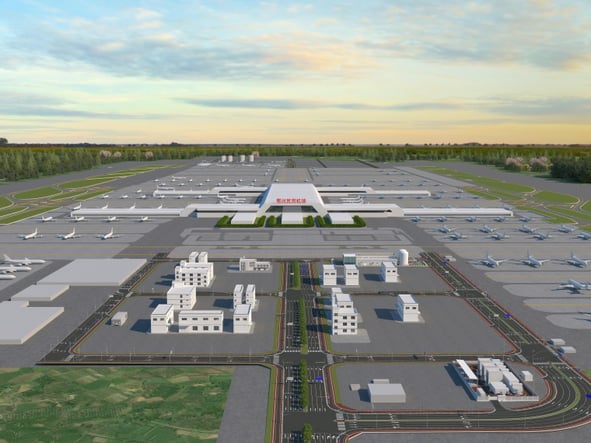Developing an Air Cargo Hub for all of China
Airport operator SF Express determined that they needed a new facility in the city of Ezhou to improve the flow of goods through China. The proposed Ezhou Civil Airport would serve as a national air cargo hub allowing large logistics companies to ship 33 million tons of cargo each year.
The airport would also accommodate 15 million passengers annually. Beijing General Municipal Engineering Design & Research Institute was tasked with building the CNY 1.49 billion facility. In addition to developing eight main buildings, they needed to coordinate the design and construction of a wide variety of elements, including 14 roads, water and sewage pumping stations, a 110-kilovolt substation, a 10-kilovolt switching station, a garbage collection station, and comprehensive pipe rack work. They also had to minimize the project’s environmental impact by implementing the most sustainable workflows.
Airport Design Project Too Complex for 2D
As part of the project, Beijing General Municipal Engineering Design & Research Institute wanted to develop a technically sophisticated design with rigorous construction standards that would ensure quality and reduce environmental impact.
They began the project by using 2D drawings, but quickly realized that they could not provide the level of coordination and visualization needed. 2D design required designers in each of the 27 project disciplines to verify their deliverables with designers in other disciplines, which was unintuitive, time consuming, and labor intensive. Because they had to connect a wide variety of elements, including complex roads and pipelines, 2D design presented the risk of accidentally creating significant design clashes that could cause delays and rework. They realized that without a unified 3D workflow and a digital twin, they could not ensure design quality and collaboration among teams.

Image: Courtesy of Beijing General Municipal Engineering Design &
Research Institute Co., Ltd.
Collaborating and Federating with Bentley Applications
After researching potential digital solutions, Beijing General Municipal Engineering Design & Research Institute determined that Bentley applications could help them with going digital, ease collaboration between teams and stakeholders, and ensure quality. First, they used ProjectWise to establish a connected data environment, ensuring specialist teams in multiple locations could collaborate without causing clashes.
By using MicroStation, OpenBuildings, OpenBridge Modeler, and OpenRoads they created 3D models of 106,000 elements. The resulting federated visualization helped teams determine the ideal interconnections between pipelines, the HVAC system, the main structures, internal facilities, and power cables. LEGION allowed them to create optimal paths for both cargo and passengers that would keep air travel on schedule. Lastly, virtual flythroughs enabled with LumenRT helped them efficiently use available land, reduce the energy consumption of heavy machinery, and prevent construction waste.
Eliminating Clashes and Improving Quality
By switching to a digital workflow and creating 3D models of all elements, Beijing General Municipal Engineering Design & Research Institute greatly improved development of the airport. Integrating the varied disciplines into a single design environment eliminated blind spots, streamlined collaboration among 27 disciplines, and improved the quality of the design.
Visualization helped all teams and stakeholders understand the design intent, which led them to identifying and eliminating clashes – 108 in the pipe network alone. They finished the design in eight months, three months ahead of schedule, while lowering costs by 18%. Creating a simulation of the construction process identified and resolved 32 potential issues in advance, shortening the construction period by 35 days and lessening its impact on the environment.
Watch the Project Summary
Facts
- Beijing General Municipal Engineering Design & Research Institute needed to improve collaboration among 27 disciplines to design and build an airport that would serve as an air cargo hub.
- Bentley applications helped them federate 106,000 elements into a single 3D model, providing strong visualization and helping to detect and eliminate clashes.
- Digital workflows improved the airport design, cut the design time by three months, and reduced costs by 18%.
 “Constructing an airport is complex. We have challenges with collaboration and coordination. We have technical problems. We have model and data sharing issues. Bentley provides us with professional solutions to these challenges, making it possible to achieve our goals and realize our digital transformation.”
“Constructing an airport is complex. We have challenges with collaboration and coordination. We have technical problems. We have model and data sharing issues. Bentley provides us with professional solutions to these challenges, making it possible to achieve our goals and realize our digital transformation.”
Rui Wang
Project Coordinator
Beijing General Municipal Engineering Design & Research Institute Co., Ltd.
